Introduction to Bangladesh Philately
by
Takashi Kurosaki
(Last Revision: June 1, 2004)
Source: Takashi Kurosaki, "Introduction to Bangladesh Philately," Ujan Jatri (a research journal on society and culture in Bangladesh), No. 13, November 2002, pp.46-51.
1. Bangladesh and Japan
 On April 12, 2002, four stamps on South Asia were issued from Japanese post offices. One of them celebrates 30 years of diplomatic relations between Bangladesh and Japan (shown left, the left stamp). Its design shows Paharpur Monastery and a terra cotta image there. Is this the first Japanese stamp on Bangladesh? Not really. The right stamp (shown left) was issued in 1995, which celebrated 30 years of Japan Overseas Cooperation Volunteers (JOCV). The official note from the Japanese Ministry of Post and Communications explains that the stamps shows a JOCV lady helping a Bangladeshi lady learning letters.
On April 12, 2002, four stamps on South Asia were issued from Japanese post offices. One of them celebrates 30 years of diplomatic relations between Bangladesh and Japan (shown left, the left stamp). Its design shows Paharpur Monastery and a terra cotta image there. Is this the first Japanese stamp on Bangladesh? Not really. The right stamp (shown left) was issued in 1995, which celebrated 30 years of Japan Overseas Cooperation Volunteers (JOCV). The official note from the Japanese Ministry of Post and Communications explains that the stamps shows a JOCV lady helping a Bangladeshi lady learning letters.
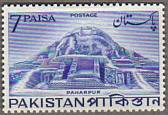 Since a Paharpur stamp issued by Bangladesh is missing from my collection, let me show you the first stamp on Paharpur Monastery. The stamp shown right was issued in 1963. At that time, Bangladesh was East Pakistan so that Pakistani stamps were used. The stamp is from a four-stamp set on archaeology in (East and West) Pakistan. This set of four stamps are beautifully designed and carefully printed by an engraving process. Note that the country name "PAKISTAN" is shown in three languages: English, Urdu, and Bengali.
Since a Paharpur stamp issued by Bangladesh is missing from my collection, let me show you the first stamp on Paharpur Monastery. The stamp shown right was issued in 1963. At that time, Bangladesh was East Pakistan so that Pakistani stamps were used. The stamp is from a four-stamp set on archaeology in (East and West) Pakistan. This set of four stamps are beautifully designed and carefully printed by an engraving process. Note that the country name "PAKISTAN" is shown in three languages: English, Urdu, and Bengali.

2. Postage Stamps of Bangladesh
 East Pakistan declared independence on March 26, 1971, under the leadership of Mujibur Rahman. The independence movement was repressed by mighty army from West Pakistan and then went into a guerilla war. To appeal to the world , the interim government of Bangladesh issued the first stamps of Bangladesh on July 29, 1971 (shown left). However, under the civil war, there was no postal administration under that government. These stamps were used only after the de facto independence of Bangladesh, mostly after January 1972.
East Pakistan declared independence on March 26, 1971, under the leadership of Mujibur Rahman. The independence movement was repressed by mighty army from West Pakistan and then went into a guerilla war. To appeal to the world , the interim government of Bangladesh issued the first stamps of Bangladesh on July 29, 1971 (shown left). However, under the civil war, there was no postal administration under that government. These stamps were used only after the de facto independence of Bangladesh, mostly after January 1972.
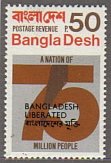 On December 16, 1971, Dacca fell to India and Bangladesh achieved its independence in the real sense. On December 20, the eight Bangladeshi stamps were overprinted to celebrate the liberation (shown right). Since the currency unit was changed from Rupee into Taka, the liberation issues were the last Bangladeshi stamps in Rupees denomination.
On December 16, 1971, Dacca fell to India and Bangladesh achieved its independence in the real sense. On December 20, the eight Bangladeshi stamps were overprinted to celebrate the liberation (shown right). Since the currency unit was changed from Rupee into Taka, the liberation issues were the last Bangladeshi stamps in Rupees denomination.
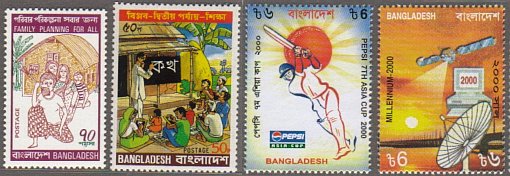 According to Scott's Postage Stamps Catalogue, about 650 regular stamps and 50 official stamps were issued from Bangladesh by the end of year 2000. Some of them are shown left. One of the most popular themes on Bangladeshi stamps is freedom fighters. Because all the stamps are relatively new, the majority of Bangladeshi stamps are not expensive. It is more difficult to collect used stamps for some issues than to collect mint stamps. First, the number of postage stamps consumed on mails per capita is much smaller in Bangladesh than in India or in Pakistan. Second, some of the commemorative stamps were sold mainly through foreign agencies and were available domestically only in a limited quantity. On Scott's, such issues are shown with italicized valuation for used copies.
According to Scott's Postage Stamps Catalogue, about 650 regular stamps and 50 official stamps were issued from Bangladesh by the end of year 2000. Some of them are shown left. One of the most popular themes on Bangladeshi stamps is freedom fighters. Because all the stamps are relatively new, the majority of Bangladeshi stamps are not expensive. It is more difficult to collect used stamps for some issues than to collect mint stamps. First, the number of postage stamps consumed on mails per capita is much smaller in Bangladesh than in India or in Pakistan. Second, some of the commemorative stamps were sold mainly through foreign agencies and were available domestically only in a limited quantity. On Scott's, such issues are shown with italicized valuation for used copies.

3. Pre-Bangladesh Period
The area currently in Bangladesh covers regions that were partitioned from India on August 1947 as "East Pakistan". The East Pakistan area included an eastern half of British Province of Bengal and the Sylhet District of Assam Province. Therefore, philately on the pre-Bangladesh period is divided into two periods: the British Period until 1947 and the Pakistan period from 1947 to 1971.
In India, the modern postal administration began in 1854 when the East India Company issued stamps in four values: 1/2 anna, 1 anna, 2 annas, and 4 annas. It was much earlier than other Asian countries. For instance, it was not until 1871 that the first postage stamps were issued in Japan. In 1854, India, there were four Postal Circles: Bengal (including Assam, Bihar & Orissa, Burma, and Singapore), North-West Provinces, Madras, and Bombay (including Scinde, Hyderabad Deccan, and Middle East). The area currently in Bangladesh was included in the Bengal Circle. There were 85 Sudder (Head) Post Offices in the Bengal Circle but only 12 of them belonged to East Bengal.

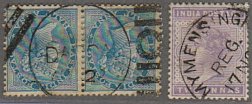 The 1854 issue of East India (shown left) is the first stamp of Bangladesh in the sense that it was the first postage stamp used in the area currently in Bangladesh. Unfortunately, it is not possible to identify the post office that cancelled the half anna stamp shown. Later, the use of date stamps to cancel postage stamps began later. The Queen Victoria stamps (shown right) were cancelled with the post office names: 1/2 anna blues stamps were used in Dacca and two anna lilac stamp was used in Mymensingh. Both were used in the late nineteenth century.
The 1854 issue of East India (shown left) is the first stamp of Bangladesh in the sense that it was the first postage stamp used in the area currently in Bangladesh. Unfortunately, it is not possible to identify the post office that cancelled the half anna stamp shown. Later, the use of date stamps to cancel postage stamps began later. The Queen Victoria stamps (shown right) were cancelled with the post office names: 1/2 anna blues stamps were used in Dacca and two anna lilac stamp was used in Mymensingh. Both were used in the late nineteenth century.
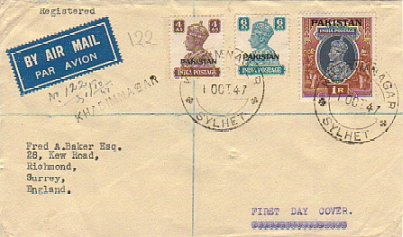 On August 14, 1947, Pakistan became an independent country, consisting of two wings (East Pakistan and West Pakistan) separating over the Republic of India. The name PAKISTAN implied the seed of Bangladeshi independence movement. The word was created as "P" from Punjab, "A" from Afghans (the majority of NWFP people), "K" from Kashmir, "S" from "Sind", and "TAN" from Baluchistan. All these regions were in West Pakistan. Letter "B" from Bengal or Bangladesh was found nowhere.
On August 14, 1947, Pakistan became an independent country, consisting of two wings (East Pakistan and West Pakistan) separating over the Republic of India. The name PAKISTAN implied the seed of Bangladeshi independence movement. The word was created as "P" from Punjab, "A" from Afghans (the majority of NWFP people), "K" from Kashmir, "S" from "Sind", and "TAN" from Baluchistan. All these regions were in West Pakistan. Letter "B" from Bengal or Bangladesh was found nowhere.
Because of the turmoil due to the Partition of British India, the new state of Pakistan could not afford a commemorative stamp. One and a half months later, on October 1, 1947, new stamps of Pakistan were issued, which were British Indian stamps overprinted "PAKISTAN" by India's Printing Authority at Nasik. The envelope shown left is a First Day Cover of these stamps cancelled at Khadimnagar Post Office, Sylhet, East Pakistan (currently in Bangladesh).
 "Pakistan Used in Bangladesh," or those Pakistani stamps used in East Pakistan during 1947-71, are much easier to collect than "British India used in Bangladesh." The 6 annas ultramarine stamp was used in Chittagong and the 50 paisa cotton stamp was used in Dacca (shown right). Nevertheless, considering that the population of East Pakistan was a little more than that of West Pakistan, stamps cancelled by the East Pakistan post offices are fewer than those cancelled by the West Pakistan post offices. This gap could reflect the economic disparity between the eastern and western wings of Pakistan.
"Pakistan Used in Bangladesh," or those Pakistani stamps used in East Pakistan during 1947-71, are much easier to collect than "British India used in Bangladesh." The 6 annas ultramarine stamp was used in Chittagong and the 50 paisa cotton stamp was used in Dacca (shown right). Nevertheless, considering that the population of East Pakistan was a little more than that of West Pakistan, stamps cancelled by the East Pakistan post offices are fewer than those cancelled by the West Pakistan post offices. This gap could reflect the economic disparity between the eastern and western wings of Pakistan.
The official language(s) is a politically sensitive issue. In East Pakistan, this was indeed the beginning of the independence movement. On Pakistani stamps, earlier ones had "Pakistan" in both English and Urdu (see the 6 anna stamps above). In 1956, when Bengali language became one of the national languages, stamps began to show "Pakistan" in three languages: English, Urdu, and Bengali (see the 50 paisa stamp above).

4. Postal History during the Independence War
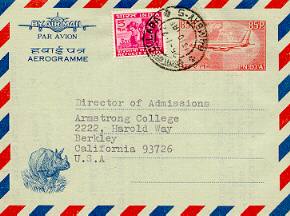 The postal history during the Independence War is particularly interesting from philatelic viewpoints.
The postal history during the Independence War is particularly interesting from philatelic viewpoints.
When the independence movement in East Pakistan went into a civil war, millions of refugees fled into India from East Pakistan. The refugee problem was one of the reasons for the Government of India to intervene into a war with Pakistan. To accommodate the expenses for the refugees, the Government of India imposed a Refugee Relief Tax of 5 paise on every mail, starting from November 1971. When the tax stamps were not available, local post masters were allowed to overprint "Refugee Tax" on regular 5p stamps. The envelope on the left is an aerogram sent from Bombay to California, USA, on January 1972. In addition to the 85p postal rate, a carmine 5p stamp was adhered. It is the definitive version of the refugee relief tax stamps. The tax was levied until the end of March 1973.
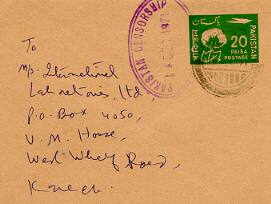 When India and Pakistan went into a war officially, the Government of Pakistan began postal censorship on civilian mails. This is in sharp contrast to India, where no explicit censorship was implemented. The envelope shown right was sent from Karachi on December 14, 1971. A violet censorship mark was stamped on the envelope.
When India and Pakistan went into a war officially, the Government of Pakistan began postal censorship on civilian mails. This is in sharp contrast to India, where no explicit censorship was implemented. The envelope shown right was sent from Karachi on December 14, 1971. A violet censorship mark was stamped on the envelope.
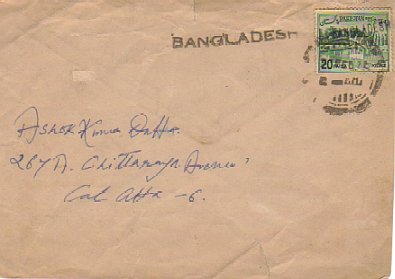 Immediately after the establishment of Bangladesh's Government in January 1972, the post offices did not afford printing new stamps of Bangladesh. Instead, they overprinted Pakistani stamps with its new country name "BANGLADESH". The overprints were in English only (as shown in the envelope left), in both English and Bengali letters, and in ; Bengali letters only. In the latter half of 1972, new Bangladeshi stamps were provided to post offices in the country. As a result, on February 1973, Pakistani stamps, even with "BANGLADESH" overprints, became invalid throughout Bangladesh.
Immediately after the establishment of Bangladesh's Government in January 1972, the post offices did not afford printing new stamps of Bangladesh. Instead, they overprinted Pakistani stamps with its new country name "BANGLADESH". The overprints were in English only (as shown in the envelope left), in both English and Bengali letters, and in ; Bengali letters only. In the latter half of 1972, new Bangladeshi stamps were provided to post offices in the country. As a result, on February 1973, Pakistani stamps, even with "BANGLADESH" overprints, became invalid throughout Bangladesh.
 The third Indo-Pakistan War was officially over, as Simla Agreements were signed between India and Pakistan on July 1972. However, prisoners of war remained as the most serious post-war problem to be solved. The number of prisoners of war was more than one lakh (100,000) at the peak time. The majority of them are Pakistanis detained in India (see the stamp on the right) but the prisoners detained in Pakistan were also numerous. Agreements of sending back the prisoners were signed only in August 1973.
The third Indo-Pakistan War was officially over, as Simla Agreements were signed between India and Pakistan on July 1972. However, prisoners of war remained as the most serious post-war problem to be solved. The number of prisoners of war was more than one lakh (100,000) at the peak time. The majority of them are Pakistanis detained in India (see the stamp on the right) but the prisoners detained in Pakistan were also numerous. Agreements of sending back the prisoners were signed only in August 1973.
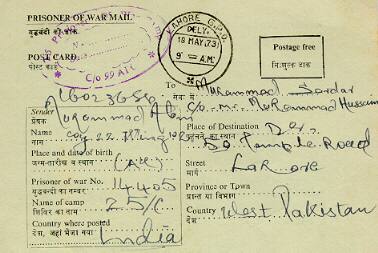 According to the international treaty on the prisoners of war, the prisoners were allowed to send mails to their family. Therefore, special arrangements were made among India, Pakistan, and Bangladesh to send these prisoners of war (POW) mails from camps in Pakistan. The photo on the left shows a post card sent by a Pakistani POW detained in India. It was sent to the family via Lahore GPO on May 1973. All the POW mails were censored so that the latter on the backside of this post card is also a very mechanic mail asking about the well-being of his family.
According to the international treaty on the prisoners of war, the prisoners were allowed to send mails to their family. Therefore, special arrangements were made among India, Pakistan, and Bangladesh to send these prisoners of war (POW) mails from camps in Pakistan. The photo on the left shows a post card sent by a Pakistani POW detained in India. It was sent to the family via Lahore GPO on May 1973. All the POW mails were censored so that the latter on the backside of this post card is also a very mechanic mail asking about the well-being of his family.
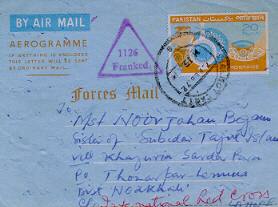 The blue envelope shown right is an example of POW mails, sent from a Bangladeshi prisoner detained in Pakistan. The envelope was cancelled by a camp post office at Sialkot (February 7, 1972) with a violet, triangle censorship mark "Franked". The mail, addressed to his family living in Noakhali, Bangladesh, was sent via the International Red Cross (IRC), Lahore, Pakistan. When his family wanted to reply, they sent mails c/o the IRC, Dacca.
The blue envelope shown right is an example of POW mails, sent from a Bangladeshi prisoner detained in Pakistan. The envelope was cancelled by a camp post office at Sialkot (February 7, 1972) with a violet, triangle censorship mark "Franked". The mail, addressed to his family living in Noakhali, Bangladesh, was sent via the International Red Cross (IRC), Lahore, Pakistan. When his family wanted to reply, they sent mails c/o the IRC, Dacca.
Postal history materials shown here are only some of the materials included in my collection. I am sorry that they are not pleasant --- we do not want to pay additional tax, the censorship of civic mails is a clear violation of basic rights, and we cannot imagine the stress of those prisoners of war. The materials are living evidence of the war-induced madness for the modern history.
Back to Tak's Philately, Main Page

 On April 12, 2002, four stamps on South Asia were issued from Japanese post offices. One of them celebrates 30 years of diplomatic relations between Bangladesh and Japan (shown left, the left stamp). Its design shows Paharpur Monastery and a terra cotta image there. Is this the first Japanese stamp on Bangladesh? Not really. The right stamp (shown left) was issued in 1995, which celebrated 30 years of Japan Overseas Cooperation Volunteers (JOCV). The official note from the Japanese Ministry of Post and Communications explains that the stamps shows a JOCV lady helping a Bangladeshi lady learning letters.
On April 12, 2002, four stamps on South Asia were issued from Japanese post offices. One of them celebrates 30 years of diplomatic relations between Bangladesh and Japan (shown left, the left stamp). Its design shows Paharpur Monastery and a terra cotta image there. Is this the first Japanese stamp on Bangladesh? Not really. The right stamp (shown left) was issued in 1995, which celebrated 30 years of Japan Overseas Cooperation Volunteers (JOCV). The official note from the Japanese Ministry of Post and Communications explains that the stamps shows a JOCV lady helping a Bangladeshi lady learning letters. Since a Paharpur stamp issued by Bangladesh is missing from my collection, let me show you the first stamp on Paharpur Monastery. The stamp shown right was issued in 1963. At that time, Bangladesh was East Pakistan so that Pakistani stamps were used. The stamp is from a four-stamp set on archaeology in (East and West) Pakistan. This set of four stamps are beautifully designed and carefully printed by an engraving process. Note that the country name "PAKISTAN" is shown in three languages: English, Urdu, and Bengali.
Since a Paharpur stamp issued by Bangladesh is missing from my collection, let me show you the first stamp on Paharpur Monastery. The stamp shown right was issued in 1963. At that time, Bangladesh was East Pakistan so that Pakistani stamps were used. The stamp is from a four-stamp set on archaeology in (East and West) Pakistan. This set of four stamps are beautifully designed and carefully printed by an engraving process. Note that the country name "PAKISTAN" is shown in three languages: English, Urdu, and Bengali.
 East Pakistan declared independence on March 26, 1971, under the leadership of Mujibur Rahman. The independence movement was repressed by mighty army from West Pakistan and then went into a guerilla war. To appeal to the world , the interim government of Bangladesh issued the first stamps of Bangladesh on July 29, 1971 (shown left). However, under the civil war, there was no postal administration under that government. These stamps were used only after the de facto independence of Bangladesh, mostly after January 1972.
East Pakistan declared independence on March 26, 1971, under the leadership of Mujibur Rahman. The independence movement was repressed by mighty army from West Pakistan and then went into a guerilla war. To appeal to the world , the interim government of Bangladesh issued the first stamps of Bangladesh on July 29, 1971 (shown left). However, under the civil war, there was no postal administration under that government. These stamps were used only after the de facto independence of Bangladesh, mostly after January 1972. On December 16, 1971, Dacca fell to India and Bangladesh achieved its independence in the real sense. On December 20, the eight Bangladeshi stamps were overprinted to celebrate the liberation (shown right). Since the currency unit was changed from Rupee into Taka, the liberation issues were the last Bangladeshi stamps in Rupees denomination.
On December 16, 1971, Dacca fell to India and Bangladesh achieved its independence in the real sense. On December 20, the eight Bangladeshi stamps were overprinted to celebrate the liberation (shown right). Since the currency unit was changed from Rupee into Taka, the liberation issues were the last Bangladeshi stamps in Rupees denomination. According to Scott's Postage Stamps Catalogue, about 650 regular stamps and 50 official stamps were issued from Bangladesh by the end of year 2000. Some of them are shown left. One of the most popular themes on Bangladeshi stamps is freedom fighters. Because all the stamps are relatively new, the majority of Bangladeshi stamps are not expensive. It is more difficult to collect used stamps for some issues than to collect mint stamps. First, the number of postage stamps consumed on mails per capita is much smaller in Bangladesh than in India or in Pakistan. Second, some of the commemorative stamps were sold mainly through foreign agencies and were available domestically only in a limited quantity. On Scott's, such issues are shown with italicized valuation for used copies.
According to Scott's Postage Stamps Catalogue, about 650 regular stamps and 50 official stamps were issued from Bangladesh by the end of year 2000. Some of them are shown left. One of the most popular themes on Bangladeshi stamps is freedom fighters. Because all the stamps are relatively new, the majority of Bangladeshi stamps are not expensive. It is more difficult to collect used stamps for some issues than to collect mint stamps. First, the number of postage stamps consumed on mails per capita is much smaller in Bangladesh than in India or in Pakistan. Second, some of the commemorative stamps were sold mainly through foreign agencies and were available domestically only in a limited quantity. On Scott's, such issues are shown with italicized valuation for used copies.


 The 1854 issue of East India (shown left) is the first stamp of Bangladesh in the sense that it was the first postage stamp used in the area currently in Bangladesh. Unfortunately, it is not possible to identify the post office that cancelled the half anna stamp shown. Later, the use of date stamps to cancel postage stamps began later. The Queen Victoria stamps (shown right) were cancelled with the post office names: 1/2 anna blues stamps were used in Dacca and two anna lilac stamp was used in Mymensingh. Both were used in the late nineteenth century.
The 1854 issue of East India (shown left) is the first stamp of Bangladesh in the sense that it was the first postage stamp used in the area currently in Bangladesh. Unfortunately, it is not possible to identify the post office that cancelled the half anna stamp shown. Later, the use of date stamps to cancel postage stamps began later. The Queen Victoria stamps (shown right) were cancelled with the post office names: 1/2 anna blues stamps were used in Dacca and two anna lilac stamp was used in Mymensingh. Both were used in the late nineteenth century. On August 14, 1947, Pakistan became an independent country, consisting of two wings (East Pakistan and West Pakistan) separating over the Republic of India. The name PAKISTAN implied the seed of Bangladeshi independence movement. The word was created as "P" from Punjab, "A" from Afghans (the majority of NWFP people), "K" from Kashmir, "S" from "Sind", and "TAN" from Baluchistan. All these regions were in West Pakistan. Letter "B" from Bengal or Bangladesh was found nowhere.
On August 14, 1947, Pakistan became an independent country, consisting of two wings (East Pakistan and West Pakistan) separating over the Republic of India. The name PAKISTAN implied the seed of Bangladeshi independence movement. The word was created as "P" from Punjab, "A" from Afghans (the majority of NWFP people), "K" from Kashmir, "S" from "Sind", and "TAN" from Baluchistan. All these regions were in West Pakistan. Letter "B" from Bengal or Bangladesh was found nowhere. "Pakistan Used in Bangladesh," or those Pakistani stamps used in East Pakistan during 1947-71, are much easier to collect than "British India used in Bangladesh." The 6 annas ultramarine stamp was used in Chittagong and the 50 paisa cotton stamp was used in Dacca (shown right). Nevertheless, considering that the population of East Pakistan was a little more than that of West Pakistan, stamps cancelled by the East Pakistan post offices are fewer than those cancelled by the West Pakistan post offices. This gap could reflect the economic disparity between the eastern and western wings of Pakistan.
"Pakistan Used in Bangladesh," or those Pakistani stamps used in East Pakistan during 1947-71, are much easier to collect than "British India used in Bangladesh." The 6 annas ultramarine stamp was used in Chittagong and the 50 paisa cotton stamp was used in Dacca (shown right). Nevertheless, considering that the population of East Pakistan was a little more than that of West Pakistan, stamps cancelled by the East Pakistan post offices are fewer than those cancelled by the West Pakistan post offices. This gap could reflect the economic disparity between the eastern and western wings of Pakistan.
 The postal history during the Independence War is particularly interesting from philatelic viewpoints.
The postal history during the Independence War is particularly interesting from philatelic viewpoints. When India and Pakistan went into a war officially, the Government of Pakistan began postal censorship on civilian mails. This is in sharp contrast to India, where no explicit censorship was implemented. The envelope shown right was sent from Karachi on December 14, 1971. A violet censorship mark was stamped on the envelope.
When India and Pakistan went into a war officially, the Government of Pakistan began postal censorship on civilian mails. This is in sharp contrast to India, where no explicit censorship was implemented. The envelope shown right was sent from Karachi on December 14, 1971. A violet censorship mark was stamped on the envelope. Immediately after the establishment of Bangladesh's Government in January 1972, the post offices did not afford printing new stamps of Bangladesh. Instead, they overprinted Pakistani stamps with its new country name "BANGLADESH". The overprints were in English only (as shown in the envelope left), in both English and Bengali letters, and in ; Bengali letters only. In the latter half of 1972, new Bangladeshi stamps were provided to post offices in the country. As a result, on February 1973, Pakistani stamps, even with "BANGLADESH" overprints, became invalid throughout Bangladesh.
Immediately after the establishment of Bangladesh's Government in January 1972, the post offices did not afford printing new stamps of Bangladesh. Instead, they overprinted Pakistani stamps with its new country name "BANGLADESH". The overprints were in English only (as shown in the envelope left), in both English and Bengali letters, and in ; Bengali letters only. In the latter half of 1972, new Bangladeshi stamps were provided to post offices in the country. As a result, on February 1973, Pakistani stamps, even with "BANGLADESH" overprints, became invalid throughout Bangladesh. The third Indo-Pakistan War was officially over, as Simla Agreements were signed between India and Pakistan on July 1972. However, prisoners of war remained as the most serious post-war problem to be solved. The number of prisoners of war was more than one lakh (100,000) at the peak time. The majority of them are Pakistanis detained in India (see the stamp on the right) but the prisoners detained in Pakistan were also numerous. Agreements of sending back the prisoners were signed only in August 1973.
The third Indo-Pakistan War was officially over, as Simla Agreements were signed between India and Pakistan on July 1972. However, prisoners of war remained as the most serious post-war problem to be solved. The number of prisoners of war was more than one lakh (100,000) at the peak time. The majority of them are Pakistanis detained in India (see the stamp on the right) but the prisoners detained in Pakistan were also numerous. Agreements of sending back the prisoners were signed only in August 1973.  According to the international treaty on the prisoners of war, the prisoners were allowed to send mails to their family. Therefore, special arrangements were made among India, Pakistan, and Bangladesh to send these prisoners of war (POW) mails from camps in Pakistan. The photo on the left shows a post card sent by a Pakistani POW detained in India. It was sent to the family via Lahore GPO on May 1973. All the POW mails were censored so that the latter on the backside of this post card is also a very mechanic mail asking about the well-being of his family.
According to the international treaty on the prisoners of war, the prisoners were allowed to send mails to their family. Therefore, special arrangements were made among India, Pakistan, and Bangladesh to send these prisoners of war (POW) mails from camps in Pakistan. The photo on the left shows a post card sent by a Pakistani POW detained in India. It was sent to the family via Lahore GPO on May 1973. All the POW mails were censored so that the latter on the backside of this post card is also a very mechanic mail asking about the well-being of his family. The blue envelope shown right is an example of POW mails, sent from a Bangladeshi prisoner detained in Pakistan. The envelope was cancelled by a camp post office at Sialkot (February 7, 1972) with a violet, triangle censorship mark "Franked". The mail, addressed to his family living in Noakhali, Bangladesh, was sent via the International Red Cross (IRC), Lahore, Pakistan. When his family wanted to reply, they sent mails c/o the IRC, Dacca.
The blue envelope shown right is an example of POW mails, sent from a Bangladeshi prisoner detained in Pakistan. The envelope was cancelled by a camp post office at Sialkot (February 7, 1972) with a violet, triangle censorship mark "Franked". The mail, addressed to his family living in Noakhali, Bangladesh, was sent via the International Red Cross (IRC), Lahore, Pakistan. When his family wanted to reply, they sent mails c/o the IRC, Dacca.